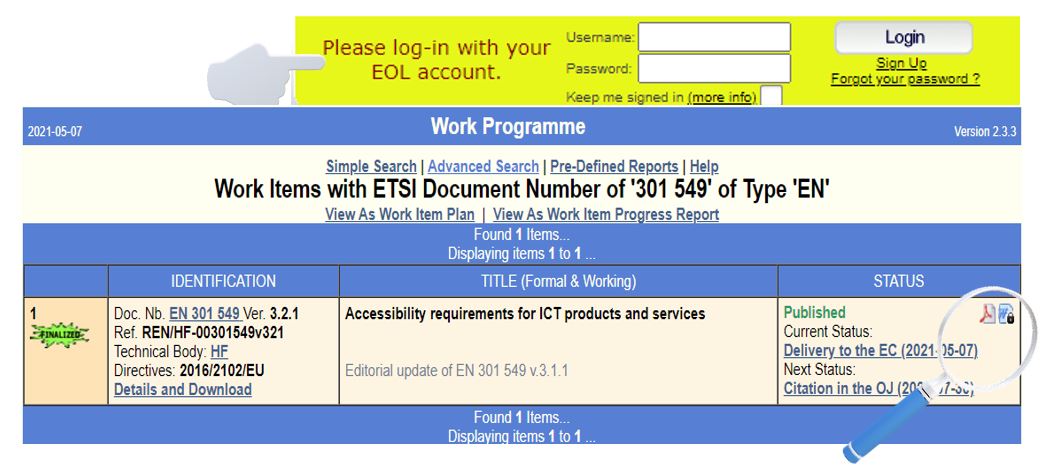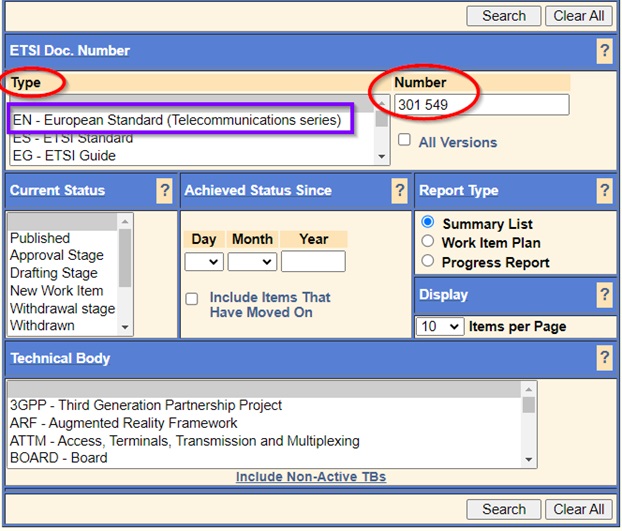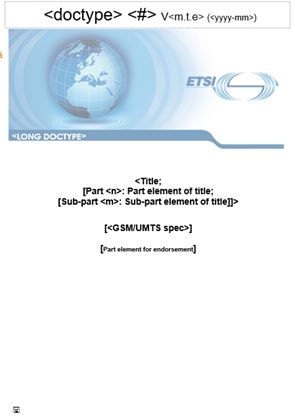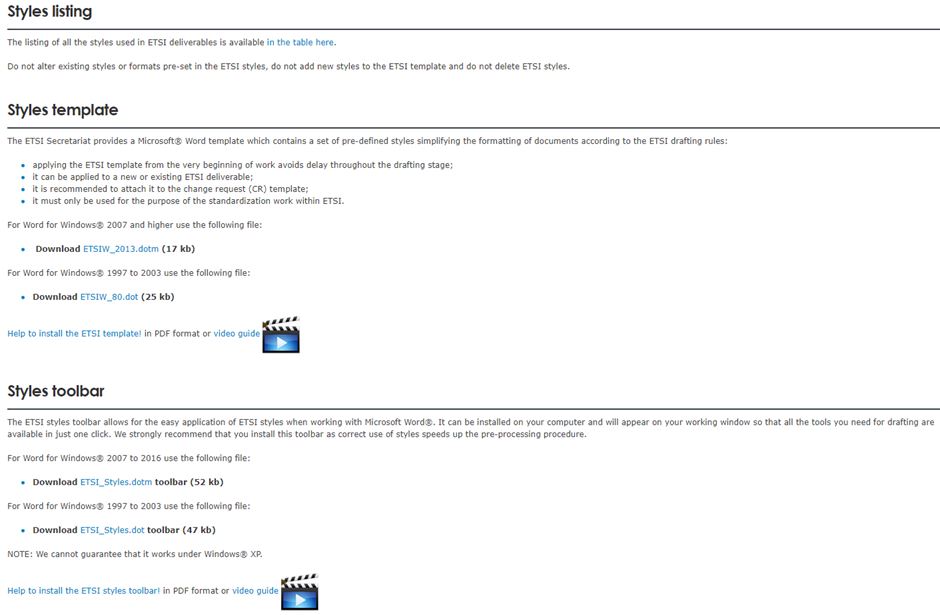Experts Guide: Difference between revisions
| Line 120: | Line 120: | ||
This depends on the type of ETSI Deliverable being produced. For example, the process is different if it is a GS or an EN. | This depends on the type of ETSI Deliverable being produced. For example, the process is different if it is a GS or an EN. | ||
All the details are available by clicking here: https:// | All the details are available by clicking here: https://ocgwiki.etsi.org/index.php?title=ETSI_Standards_Making_Process_Guide. | ||
== Making a contribution on the ETSI Portal == | == Making a contribution on the ETSI Portal == | ||
Revision as of 09:38, 14 March 2024
How to get started with your ETSI drafting
This Rapporteur’s guide has been developed to give an overview of what is useful to know when drafting an ETSI Deliverable.
When new Rapporteurs start working on a draft for ETSI for the first time, it is recommended to read this guide or view the video presentation.
Administrative requirements
Work can start after the contract (link to https://portal.etsi.org/STF/STFs/Summary/Contract-details_THC) is signed by both parties.
The initial work plan is agreed during the preparatory meeting.
Experts can book an office space for the working sessions in ETSI premises as required, with STF/TTF Leader's agreement using the Booking application (click here (https://portal.etsi.org/Portals/0/TBpages/STFs/Docs/User_Guide_Bookings_Application_v0_1.pdf) to access further details).
After the end of each month, meaning before the 7th of the following month, the work done should be confirmed, using the timesheet declaration (click here to access further details).
The STF/TTF Leader should review and validate the timesheet declaration of each expert, before the 14th of the following month.
The Funded Activities Team will do the final acceptance of all the timesheets validated by the STF/TTF Leader, starting from the 15th.
If everybody respects the agreed times and dates, all the work performed will be accounted for in a timely manner.
Travels & payments
The travel costs to attend the Projects working sessions is included in the contractual compensation. A mission travel may be requested to present the results of the Project and/or to attend related events.
The travellers should prepare a Travel Order on Notilus for the mission travels which will be validated by the STF/TTF leader and by ETSI.
A travel expense must be prepared also on Notilus with the specific details of the travel organization, to be approved by ETSI. The motivations for exceptions to the ETSI travel rules must be clearly indicated in the travel order.
Reimbursement shall be requested, according to the approved travel expense with an invoice from the company with copies of the detailed justification receipts. In the case that unexpected extra costs have been incurred, they should also be clearly indicated in the reimbursement request.
Regarding payment, FA Team will confirm the achievement of the milestones and provide you with the necessary information to issue the invoice.
The milestones that must be achieved have been defined in the preparatory meeting (see the meeting minutes) and are part of your contract. Payments will be made upon the achievement of these milestones.
Requests (for payment) during the duration of the STF/TTF can be sent to STFLink@etsi.org.
IT environment
When working in ETSI, you will have access to a desktop computer, configured with the IT environment. If any special software is required, a request must be made to the ETSI Secretariat.
editHelp! and the IT services can advise whether the use of this software is compatible with the ETSI IT policy and with the ETSI editing requirements.
When you are working from your home office, your organization must make available an IT configuration equivalent to the standard ETSI environment, in order to be able to exchange information with the other experts and the ETSI Secretariat.
This information may be found on the ETSI portal at https://portal.etsi.org/Services/editHelp/How-to-start/Supported+file+formats.
ETSI DOCBOX
A document repository area is provided on the ETSI docbox, which is accessible from both inside and outside ETSI. This contains a "Public" area, accessible in read only mode to all ETSI On Line users and a Project workarea to which access is restricted to the experts and can be used to store preliminary drafts and other confidential documents. Before leaving ETSI, you have to move the documents you need to the "docbox" area.
For each STF/TTF, a dedicated Teams workspace is available for the project members to discuss the drafts and exchange information during the project’s entire lifetime.
Open WEB pages can also be created on the ETSI Portal to present the activity of the STF/TTF to stakeholders outside ETSI.
When working in ETSI, documents can be temporarily stored on the local network but will not be accessible from outside ETSI.
Drafting your 1st deliverable
For a 1st ETSI Deliverable, it is recommended to read the booklet called Writing World Class Standards available at https://www.etsi.org/e-brochure/WritingWorldClassStandards/mobile/#p=1.
This booklet starts with the basics for Rapporteurs who are new to standardization or new to ETSI.
Guidance follows on how to choose the right type of standard, how to structure a standard and draft it, how to express the technical requirements and finally how to validate, test and maintain a standard.
Start drafting a revision
If it's not a 1st publication but a revision of an already published ETSI Deliverable to be produced, it is essential to start working on the latest published version. In case it is not sure the version you have is the latest version, it is necessary to search in the right place for the proper version.
Personal information
The ETSI Secretariat shall keep the Rapporteur informed all along the process of the development of the ETSI Deliverable. It is essential that all recorded personal details are accurate.
If not, there is a risk that this could delay the timeline of the work schedule. The name of the Rapporteur should always be provided. Please access personal details by clicking on https://portal.etsi.org/webapp/teldir/PersonalInfo.asp where it is possible to update if needed. If difficulties are experienced when updating these details, just inform the ETSI Secretariat that corrections are needed and the Technical Officer or the Standardization Support Professional or editHelp! can update the information.
ETSI skeletons
If a new ETSI Deliverable is to be drafted, the best way to start is to download the proper skeleton. These can be downloaded from this page: https://portal.etsi.org/Services/editHelp/Standards-development/Drafting/Skeletons.
ETSI skeletons and guide
At the same time and from the same location, please download the guide named "Principles for drafting an ETSI deliverable with the use of skeletons".
This guide contains all the details needed when drafting an ETSI Deliverable. It follows the complete structure of the draft from beginning to end, starting with the cover page and ending with the history box.
For example, it gives guidance on references, terms, symbols, abbreviations and details on ETSI styles on how they are supposed to be used and much more following the skeletons' structure.
It also explains how to deal with figures, tables, equations, mathematical formulae, supplementary files, etc.
All the information is summed up in this document to facilitate the drafting from an editing point of view.
ETSI videos
For a better understanding and a simplified use of the ETSI styles, it is suggested to watch these videos available at https://portal.etsi.org/Services/editHelp/Standards-development/Drafting/Styles-toolbar.
ETSI Drafting Rules (EDRs)
In order to draft an ETSI Deliverable, please refer to the ETSI Drafting Rules document - commonly named "EDRs", which is available at https://docbox.etsi.org/Board/ETSI_Directives.
Every year, the ETSI Secretariat studies the necessity to review these rules.
It is essential to use the latest updated version of the EDRs when drafting an ETSI deliverable.
Set of rules
These set of rules state what is permitted and what is not when drafting an ETSI Deliverable.
Whether dealing with normative references or informative references, normative provisions and informative recommendations the rules are not the same depending on the type of ETSI Deliverable worked on.
European Harmonised Standards have specific rules which are not the same as with Technical Reports.
It is possible to find all verbal forms for the expression of provisions which are explicitly specified in the EDRs (see clause 3). Depending on the nature of the ETSI Deliverable being drafted – some provisions are not permitted.
Reproduction of third-party material is allowed only under very strict conditions in ETSI Deliverables, and this is the same with the use of tradenames and trademarks. Some communiqués have been produced to provide more guidance regarding these sensitive topics. All are available by clicking on https://portal.etsi.org/Services/editHelp/How-to-start/ETSI-Drafting-News.
The use of gender-inclusive language guide
"Using gender-inclusive language means speaking and writing in a way that does not discriminate against a particular sex, social gender or gender identity, and does not perpetuate gender stereotypes. Given the key role of language in shaping cultural and social attitudes, using gender-inclusive language is a powerful way to promote gender equality and eradicate gender bias".
https://portal.etsi.org/Portals/0/TBpages/edithelp/Docs/Guides/Use_gender_inclusive_language.pdf
Standards’ production time
How long does it take to get a ETSI Deliverable published?
This depends on the type of ETSI Deliverable being produced. For example, the process is different if it is a GS or an EN.
All the details are available by clicking here: https://ocgwiki.etsi.org/index.php?title=ETSI_Standards_Making_Process_Guide.
Making a contribution on the ETSI Portal
Information on how to use the Contribution tool on the ETSI Portal, can be found by clicking here: http://help.etsi.org/index.php?title=Contributions_application#WI_Details_tab_-_Creation_of_a_New_Deliverable.
Clean-up service
It is impossible to publish an ETSI Deliverable which is not compliant with the ETSI Drafting Rules.
To avoid such a situation, editHelp! proposes a service called "clean-up”, where it is possible to submit a draft once stable enough to be 'cleaned-up' to editHelp!.
This service is dedicated to prevent any misunderstanding and thus helps raise all blocking issues and offers practical solutions before the approval of the draft.
All the details are available on the communiqué available at https://portal.etsi.org/Portals/0/TBpages/edithelp/Docs/News_from_editHelp/ETSI_clean-up_service.pdf.
Editing checklist
An editing checklist is available at https://portal.etsi.org/Portals/0/TBpages/edithelp/Docs/ETSI_editing_checklist.pdf.
It is recommended to compare the items presented on the list with the content of the ETSI Deliverable to make sure that it is compliant with the EDRs. If doubts subsist, please contact the ETSI Secretariat (either the Technical Officer, the Support Standardization Professional or editHelp!) for support and to help solve these issues.
Some blocking issues
A document has been produced which lists the most frequent issues encountered by edithelp! that block the publication of an ETSI Deliverable if not properly addressed beforehand.
This document can found by clicking on the following link: https://portal.etsi.org/Portals/0/TBpages/edithelp/Docs/News_from_editHelp/editHelp_10_most_asked_editing_questions.pdf.
FAQ
If looking for an answer to a specific question, please consult the FAQ, by clicking on https://portal.etsi.org/Services/editHelp/To-help-you-in-your-work/FAQs.
If the answer cannot be found, it is recommended to contact editHelp! directly (https://portal.etsi.org/Services/editHelp/Contact-Us).
editHelp! website https://portal.etsi.org/Services/editHelp
To know more about editHelp! services, please watch the video tour of the editHelp! website at https://portal.etsi.org/Services/editHelp/How-to-start/editHelp-introduction.




